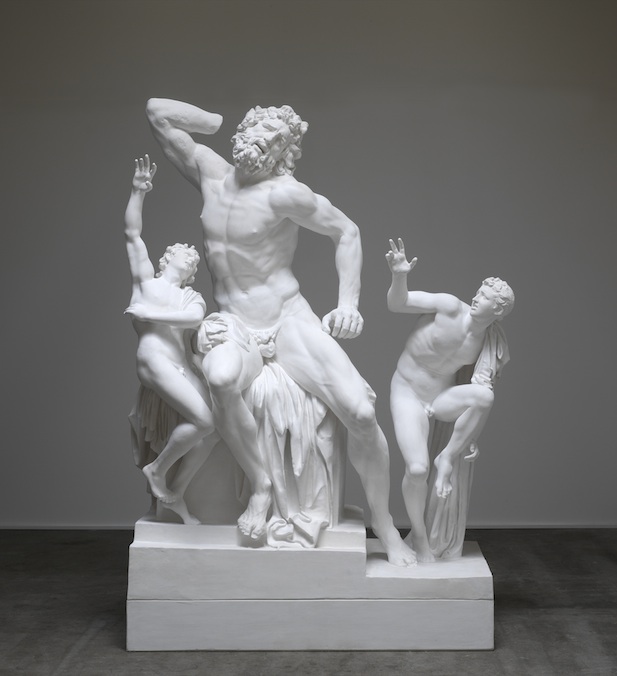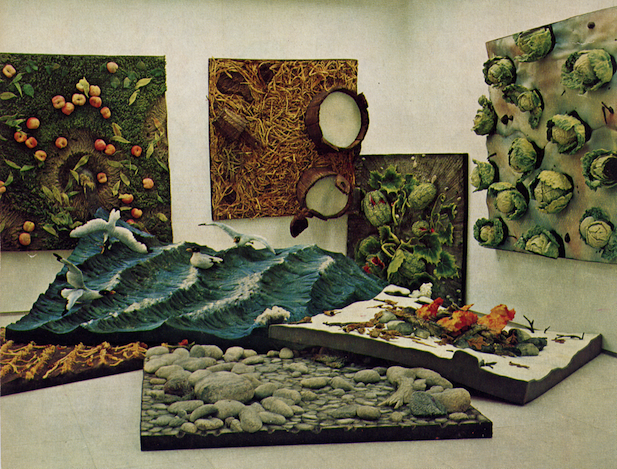BLOG

David Roberts Collection, London
VISIT
“A House of Leaves” at the
David Roberts Art Foundation, London
January 15 2013
10:36 AM
The David Roberts Art Foundation recently opened a new space in Mornington Crescent, north of its central London holdings. Accommodating visiting artists’ residencies, as well as more ephemeral and peripatetic events of an informal, discursive, experimental and outwardly pedagogical nature, the space reconceptualizes itself as “a production centre” rather than a more formal or traditional exhibition space. An ambitious new program corresponds to this updated vision, framed by the eloquent title “A House of Leaves,” taken from the unconventional form and structures of Mark Danielewski’s novel (2000), which distorts temporal and narrative conventions with jumbled footnotes, multiple narrators and an uneven typographic layout. Correspondingly, a series of performances and happenings by Nina Beier, Chosil Kil, Alvin Lucier, Eddie Peake and Steve Reich constituted this exhibition’s prelude. Three sizeable group exhibitions curated by DRAF Director, Vincent Honoré mark the first, second and third ‘movement’, inspired by key pieces from the collection by Louise Bourgeois, Gerhard Richter and Pierre Huyghe. The series ends with a selection of semi-permanent works and interventions that explore the volume of the architectural space, including those by John Cage, Marie Lund, Roman Ondák, Manuela Ribadeneira and Lawrence Weiner. (Isobel Harbison)

Courtesy of VI, VII, Oslo
STOP BY
VI, VII gallery, Oslo
January 9 2013
6:49 PM
VI, VII (pronounced “Sixes and Sevens”) is Oslo’s newest gallery, promoting Norwegian artists internationally and international artists in Norway for the first time. Founded by writer, curator and editor Esperanza Rosales, who recently moved from Brussels, where she was Director of dépendance gallery, VI VII will initially represent eight artists, including London-based sculptor Eloise Hawser, Norwegian filmmaker Lars Laumann, Berlin-based artist David Lieske and American collaborators, or conspirators, Calla Henkel & Max Pitegoff. The majority of these artists seem to reflect Rosales’ playful and experimental approach, with works structured loosely around autobiographical events or cast from the curious ephemera collected from personal experience. The first exhibition, “I’m Already a Has-Been,” saw American artist, writer, musician and publisher James Hoff present two groups of paintings based around language and abstraction “as a culture-bound illness.” One set of bold minimal paintings formulated abstraction as a cultural malady, which circulates like language; the second set was based on drawings found at stationary stores, where customers tested pens on communal notepads, expressing collective pathos and making formal allusion to Freudian analysis and Dadaist practice of automatic writing. Fitting for the gambling reference in its name, we anticipate good things here—chance encounters and fortuitous surprises. (Isobel Harbison)

Courtesy of JRP|Ringier
READ
Piero Gilardi’s retrospective monograph published by
JRP | Ringier
January 3 2013
1:39 PM
JRP|Ringier is releasing a new retrospective monograph on Turin-based Arte Povera artist Piero Gilardi (b.1942). Gilardi’s works from the late 1960s and early 1970s generated much interest, especially his large, hyper-realistic sculptures of polyurethane foam, “Nature Carpets,” designed to generate a new kind of awareness and experience of nature for the viewer. Despite some critical acclaim, the artist decided stop making art in 1972. He went on to spend the next ten years travelling extensively (staying for significant periods in both Nicaragua and Kenya, as well as on native Mohawk reserves in upstate New York) and publishing his accounts in a number of magazines, including Flash Art. During this time, he also began to organize events drawing awareness to particular political and ecological issues of the time, events that encompassed street theatre, factory protests as well as other campaigns and social initiatives. Ten years after his departure from art-making, Gilardi returned, expanding on the “Carpets” series and making other forms of sculpture, interactive installation and landscape design. In these, he again intended to draw attention to pressing ecological and environmental issues. The publication will focus on these shifts and will coincide with a major retrospective survey of his works in the Van Abbemuseum in Eindhoven, Nottingham Contemporary and Castello di Rivoli in Turin. (Isobel Harbison)
Courtesy of the artist and Whitney Museum of American Art, New York
Photograph by Sheldan C. Collins
VISIT
Richard Artschwager’s
retrospective at the
Whitney Museum
October 25 2012
6:06 PM
The Whitney Museum’s retrospective of American artist Richard Artschwager, the first since 1988, includes approximately 150 works surveying his sculpture, painting, and drawing. After working for several years as a furniture seller and designer, Artschwager began exhibiting abstract expressionist paintings in New York in the late 1950s. Several key furniture commissions around 1960 led him to explore the latent spirituality of the sculptural object. He created his first painting-object combination in 1962 using celotex and, later, formica on wood. From then on, his works have become iconic, incorporating the symbolism of architectural motifs, domestic and bourgeois interiors, and punctuation marks. Creating minimal forms with synthetic materials, geometric shapes and specific colours, Artschwager proposed a new development from Modernism that has made a significant impression on a younger generation of artists. More recently, he has returned to painting the grainy charcoal landscapes he rendered in the early 1950s. Peter Plagen of the Wall Street Journal recently wrote that, ”the works pry open your jaws of taste a little more than you’re used to… semi-pleasantly bothering me ever since I walked out of the gallery.” A semi-pleasant bothering seems nevertheless appealing. (Isobel Harbison)
Courtesy of Tensta Konsthall
VISIT
Marie-Louise Ekman at Tensta Konsthall
October 19 2012
6:03 PM
Tensta Konsthall is the first Swedish institution to host an exhibition of artist Marie-Louise Ekman’s (née De Geer Bergenstråhle) early work, made between 1969–89. The surreal and absurd depictions of a woman’s creative and domestic life traverse a variety of media, from cartoonish graphic design and painting to textile appliqués and blown glass objects. A strong connection to the history of theatre is evident in her own acting as well as her mise-en-scene. In 1969, she played herself in Öyvind Fahlström’s film Du gamla du fria (Provocation); in 1975 she scripted and played herself in Hallo baby, directed by Johan Bergenstråhle. The exhibition also provides a framework for three other artists whose practices exemplify the D.I.Y spirit of the period in which they worked. On show are prints by Sister Corita of Kent, a nun based in California, who superimposed onto bright commercial graphics excerpts from Langston Hughes, Gertrude Stein, the Beatles and Daniel Berrigan, distilling bold new spiritual messages. Works by Mladen Stilin- ovic, an artist, poet, and experimental filmmaker based in Zagreb, are also featured, including his collage, books and banners, as well as documentation of the “exhibition actions” performed in public spaces in the 1970s. Finally, included in the exhibition are works by Martha Wilson, who founded Franklin Furnace in New York and performed in Disband and Guerilla Girls.
Until January 13th at Tensta Konsthall.
Courtesy of the Artist, Galerie Diana Stieger, Amsterdam and Carlos/Ishikawa, London
MEET
Finnish artist Pilvi Takala
October 15 2012
3:23 PM
An acerbic wit, Finnish artist Pilvi Takala presents her first solo exhibition in London’s Carlos/Ishikawa Gallery. The show includes several of her well-known works, such as The Trainee (2008), a video, text-based and photographic documentation of the artist’s traineeship in an international financial services company Deloitte, whose security staff was sent into a state of panic over Takala doing precisely nothing. Footage retrieved from the company after the internship reveals her stunned colleagues squirming as the artist sat ”thinking.” A decidedly funny work that exposes the corporate world’s emphasis on passive productivity, it was a standout contribution to the New Museum’s “Ungovernables” earlier this year. Another work on show at Carlos/Ishikawa is The Real Snow White (2009), a documentation of the artist’s trip to Disneyworld Paris, where she was denied entry for being dressed as a Snow White—an unauthorized version of the ones inside the attraction park; an intervention uncovering the inherent humour in the severe copyright rules of the distinguished media conglomerate. Bag Lady (2006–8) shows Takala attracting similar public attention by carrying a large amount of bank notes around a shopping center in a transparent plastic bag, representing both a security threat and a precious potential customer. The selection at Carlos/Ishikawa will show these brazen acts among newer ones that continue to expose and undermine capitalist conventions and the societal belief systems they inform. (Isobel Harbison)
Courtesy of the Artist and Cabinet, London
VISIT
Ed Atkins at Chisenhale
October 8 2012
4:08 PM
Ed Atkins, a British artist whose work encompasses video, installation and written screenplay, will show a major new work commissioned by the Chisenhale. Us Dead Talk Love (2012) is a two channel high-definition video installation structured around a public conversation between two beings, discussing the subject of intimacy and love. The screens are configured as if in dialogue with one another, an interview presented in front of an audience gathered in the gallery. Over the last few years, Atkins’s video and performance works have combined footage of distant, remote terrains; close-up images of textural objects, candles burning, the back of a human head, motionless but vulnerable to decomposition. High definition video is imposed on us like a spectral presence. Us Dead Talk Love continues to explore the technical possibilities of video and audio editing in order to produce an effect that is both emotionally and physically challenging. Atkins will be in conversation with LUX Director Mike Sperlinger about the new work on the 1st November; on October 13th, he will give an introduction to his work, to coincide with London’s Frieze Art Fair. (Isobel Harbison)
Courtesy of Jonathan Viner, London
VISIT
“Deliquesce”
at Jonathan Viner, London
July 13 2012
9:40 AM
Deliquescence is the transition from solid to liquid—an agile word that dissolves on the tongue. It’s also the title of an exhibition at Jonathan Viner of works that chart the uneasy metamorphosis from digital image to three-dimensional thing, and how this contemporary transformation might be felt within a body. Oscar Tuazon’s large analog photograph of foliage captured in darkness has been mounted on a sizable sheet of aluminum and branded with a cross. Pamela Rosenkranz’s large Klein blue digital print has puckered under the weight of her own body. Nina Beier’s stock photos of coins dropping like aspirins in water are hung from trapezes, tethered at angles to the wall, their possible meanings (“oh no, crisis economy!,” “oh yes, make a wish!”) as pliant and flexible as their physical arrangement. Downstairs, Emily Wardill’s video traces the lines of a gymnast’s ribbon routine, the film’s grainy print giving way to unseemly digital effects as the ribbon’s line severs and crops the contours of her limbs. Berry Patten’s tropical ocean reef is framed by her laptop’s white plastic, with fake shells and painted sponges weirdly scattered on the keyboard, the picture’s foreground. In this windowless space, with its glazed blue antique tiles, an airless sense of the deep aquatic prevails. (Isobel Harbison)
Until July 29th at Jonathan Viner, London




